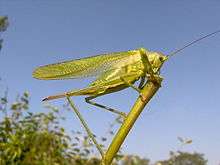Tettigonia viridissima
| Tettigonia viridissima | |
|---|---|
| | |
| Tettigonia viridissima, male | |
| Scientific classification | |
| Kingdom: | Animalia |
| Phylum: | Arthropoda |
| Class: | Insecta |
| Order: | Orthoptera |
| Family: | Tettigoniidae |
| Genus: | Tettigonia |
| Species: | T. viridissima |
| Binomial name | |
| Tettigonia viridissima (Linnaeus, 1758) | |
| Synonyms | |
| |
Tettigonia viridissima, the Great Green Bush-Cricket, is a large species of katydid or bush-cricket belonging to the family Tettigoniidae, subfamily Tettigoniinae. This species can be encountered from Europe to Mongolia, especially in meadows, grasslands, prairies and occasionally in gardens.

The adult males grow up to 28–36 millimetres (1.1–1.4 in) long, while females reach 32–42 millimetres (1.3–1.7 in). This insect is most often completely green (but there are specimens completely yellowish or with yellow legs), excluding a rust-colored band on top of the body. The organ of the stridulation of the males is generally brown.
Tettigonia viridissima is distinguished by its very long and thin antennae, which can sometimes reach up to three times the length of the body, thus differentiating them from grasshoppers, which always carry short antennae. It could be confused with Tettigonia cantans, whose wings are a centimeter shorter than the ovipositor, or Tettigonia caudata whose hind femurs bear conspicuous black spines.
The morphology of both sexes is very similar, but the female has an egg-laying organ (ovipositor) that can reach a length of 23–32 millimetres (0.91–1.26 in). It reaches the end of the elytra and is slightly curved downward. The larvae are green and as the imago show on their back a thin brown longitudinal stripe. The ovipositor can be seen from the fifth stage; the wings appear in both genders from the sixth stage.
Tettigonia viridissima is carnivorous and arboreal.[1] Its diet is mostly composed of flies, caterpillars and larvae. Unlike many grasshoppers, it is essentially active in day and night, as testified by its endless crepuscular and nocturnal singing.
![]()
.ogv.jpg)
 |
Sound of Tettigonia viridissima
Field recording in the Netherlands 35s |
| Problems playing this file? See media help. | |
The species can bite painfully but is not particularly aggressive. It is best to avoid holding the insect in the fist, as that almost guarantees a bite. They can fly, but they tend to avoid flying where possible. Most often they move "on foot" or jumps, which allow them to travel about in bushes and trees.
 Tettigonia virdissima nymph on Phleum pratense
Tettigonia virdissima nymph on Phleum pratense Females can be recognized by the ovipositor
Females can be recognized by the ovipositor Males can be recognized by the absence of the ovipositor
Males can be recognized by the absence of the ovipositor Sometimes this bush-cricket is yellow
Sometimes this bush-cricket is yellow Nymph of Tettigonia sp.
Nymph of Tettigonia sp. Anatomy of the head
Anatomy of the head Mandibles
Mandibles Hearing bubble on the forelimb
Hearing bubble on the forelimb
References
- ↑ , video of Tettigonia viridissima in a tree.